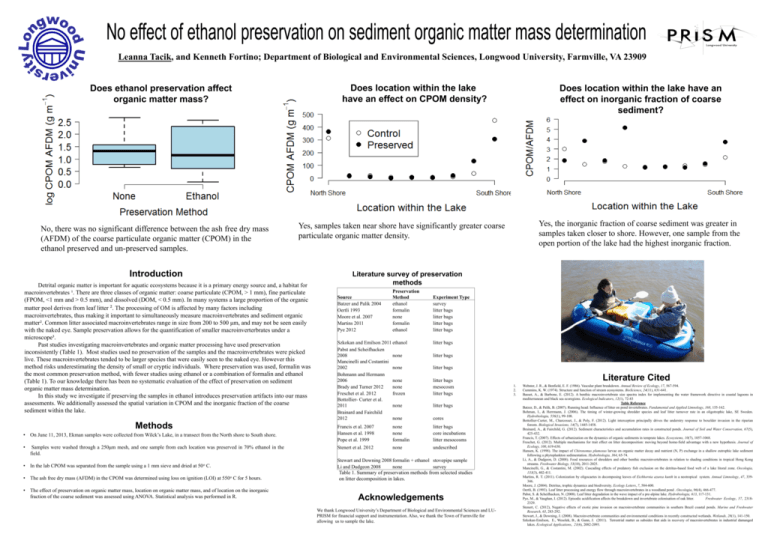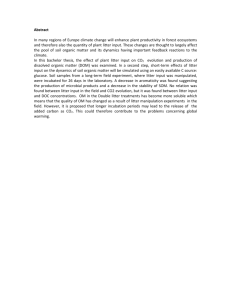Does ethanol preservation affect organic matter mass?
advertisement

Leanna Tacik, and Kenneth Fortino; Department of Biological and Environmental Sciences, Longwood University, Farmville, VA 23909 Does location within the lake have an effect on CPOM density? Does ethanol preservation affect organic matter mass? No, there was no significant difference between the ash free dry mass (AFDM) of the coarse particulate organic matter (CPOM) in the ethanol preserved and un-preserved samples. Detrital organic matter is important for aquatic ecosystems because it is a primary energy source and, a habitat for macroinvertebrates ¹. There are three classes of organic matter: coarse particulate (CPOM, > 1 mm), fine particulate (FPOM, <1 mm and > 0.5 mm), and dissolved (DOM, < 0.5 mm). In many systems a large proportion of the organic matter pool derives from leaf litter ². The processing of OM is affected by many factors including macroinvertebrates, thus making it important to simultaneously measure macroinvertebrates and sediment organic matter². Common litter associated macroinvertebrates range in size from 200 to 500 μm, and may not be seen easily with the naked eye. Sample preservation allows for the quantification of smaller macroinverterbrates under a microscope³. Past studies investigating macroinvertebrates and organic matter processing have used preservation inconsistently (Table 1). Most studies used no preservation of the samples and the macroinvertebrates were picked live. These macroinvertebrates tended to be larger species that were easily seen to the naked eye. However this method risks underestimating the density of small or cryptic individuals. Where preservation was used, formalin was the most common preservation method, with fewer studies using ethanol or a combination of formalin and ethanol (Table 1). To our knowledge there has been no systematic evaluation of the effect of preservation on sediment organic matter mass determination. In this study we investigate if preserving the samples in ethanol introduces preservation artifacts into our mass assessments. We additionally assessed the spatial variation in CPOM and the inorganic fraction of the coarse sediment within the lake. Literature survey of preservation methods Source Batzer and Palik 2004 Oertli 1993 Moore et al. 2007 Martins 2011 Pye 2012 Preservation Method ethanol formalin none formalin ethanol Experiment Type survey litter bags litter bags litter bags litter bags Szkokan and Emilson 2011 ethanol Pabst and Scheifhacken 2008 none Mancinelli and Costantini 2002 none Bohmann and Hermann 2006 none Brady and Turner 2012 none Freschet et al. 2012 frozen Bottollier- Curter et al. 2011 none Brainard and Fairchild 2012 none litter bags • On June 11, 2013, Ekman samples were collected from Wilck’s Lake, in a transect from the North shore to South shore. Francis et al. 2007 Hansen et al. 1998 Pope et al. 1999 none none formalin litter bags core incubations litter mesocosms • Stenert et al. 2012 none undescribed Samples were washed through a 250μm mesh, and one sample from each location was preserved in 70% ethanol in the field. • In the lab CPOM was separated from the sample using a 1 mm sieve and dried at 50o C. • The ash free dry mass (AFDM) in the CPOM was determined using loss on ignition (LOI) at 550o C for 5 hours. • The effect of preservation on organic matter mass, location on organic matter mass, and of location on the inorganic fraction of the coarse sediment was assessed using ANOVA. Statistical analysis was performed in R. Yes, the inorganic fraction of coarse sediment was greater in samples taken closer to shore. However, one sample from the open portion of the lake had the highest inorganic fraction. Yes, samples taken near shore have significantly greater coarse particulate organic matter density. Introduction Methods Does location within the lake have an effect on inorganic fraction of coarse sediment? litter bags litter bags litter bags mesocosm litter bags litter bags cores Stewart and Downing 2008 formalin + ethanol stovepipe sample Li and Dudgeon 2008 none survey Table 1. Summary of preservation methods from selected studies on litter decomposition in lakes. Acknowledgements We thank Longwood University’s Department of Biological and Environmental Sciences and LUPRISM for financial support and instrumentation. Also, we thank the Town of Farmville for allowing us to sample the lake. Literature Cited 1. 2. 3. Webster, J. R., & Benfield, E. F. (1986). Vascular plant breakdown. Annual Review of Ecology, 17, 567-594. Cummins, K. W. (1974). Structure and function of stream ecosystems. BioScience, 24(11), 631-641. Basset, A., & Barbone, E. (2012). A benthic macroinvertebrate size spectra index for implementing the water framework directive in coastal lagoons in mediterranean and black sea ecoregions. Ecological Indicators, 12(1), 72-83 Table Reference Batzer, D., & Palik, B. (2007). Running head: Influence of litter on pond invertebrates. Fundamental and Applied Limnology, 168, 155-162. Bohman, I., & Herrmann, J. (2006). The timing of winter-growing shredder species and leaf litter turnover rate in an oligotrophic lake, SE Sweden. Hydrobiologia, 556(1), 99-108. Bottollier-Curter, M., Charcosset, J., & Poly, F. (2012). Light interception principally drives the understry response to boxelder invasion in the riparian forests. Biological Invasions, 14(7), 1445-1458. Brainard, A., & Fairchild, G. (2012). Sediment characteristics and accumulation rates in constructed ponds. Journal of Soil and Water Conservation, 67(5), 425-432. Francis, T. (2007). Effects of urbanization on the dynamics of organic sediments in temprate lakes. Ecosystems, 10(7), 1057-1068. Freschet, G. (2012). Multiple mechanisms for trait effect on litter decomposition: moving beyond home-field advantage with a new hypothesis. Journal of Ecology, 100, 619-630. Hansen, K. (1998). The impact of Chironomus plumosus larvae on organic matter decay and nutrient (N, P) exchange in a shallow eutrophic lake sediment following a phytoplankton sedimentation. Hydrobiologia, 364, 65-74. Li, A., & Dudgeon, D. (2008). Food resources of shredders and other benthic macroinvertebrates in relation to shading conditions in tropical Hong Kong streams. Freshwater Biology, 53(10), 2011-2025. Mancinelli, G., & Costantini, M. (2002). Cascading effects of predatory fish exclusion on the detritus-based food web of a lake litoral zone. Oecologia, 133(3), 402-411. Martins, R. T. (2011). Colonization by oligocaetes in decomposing leaves of Eichhornia azurea kunth in a neotropical system. Annual Limnology, 47, 339346. Moore, J. (2004). Detritus, trophic dynamics and biodiversity. Ecology Letters, 7, 584-600. Oertli, B. (1993). Leaf litter processing and energy flow through macroinvertebrates in a woodland pond . Oecologia, 96(4), 466-477. Pabst, S. & Scheifhacken, N. (2008). Leaf litter degradation in the wave impact of a pre-alpine lake. Hydrobiologia, 613, 117-131. Pye, M., & Vaughan, I. (2012). Episodic acidification affects the breakdown and invertebrate colonisation of oak litter. Freshwater Ecology, 57, 23182329. Stenert, C. (2012), Negative effects of exotic pine invasion on macroinvertebrate communities in southern Brazil coastal ponds. Marine and Freshwater Research, 63, 283-292. Stewart, J., & Downing, J. (2008). Macroinvertebrate communities and environmental conditions in recently constructed wetlands. Wetlands, 28(1), 141-150. Szkokan-Emilson, E., Wesolek, B., & Gunn, J. (2011). Terrestrial matter as subsides that aids in recovery of macroinvertebrates in industrial damanged lakes. Ecological Applications, 21(6), 2082-2093.






